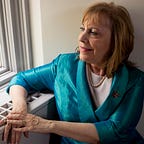For All Who Have Been Scarred By Art Teachers, But Saved By Art
This is a column for anyone who’s ever been told by a teacher that they can’t draw or paint and shouldn’t even try. It is a confirmation that we are all, in our own way, artists. And, it is a message about how images can lead us to the doorstep of the sacred.
One of the finest, most versatile artists I know is Pat Pickett of Ashland City, TN, who works mainly in fabric but has done astoundingly creative work in other media as well. Pat is also a spiritual director. She recalls being punished by a teacher in elementary school for coloring a cow purple.
“Cows aren’t purple,” the teacher scolded Pat. The teacher didn’t give Pat a chance to explain that back in Iowa, Pat’s grandmother often treated her and her cousins to vanilla ice cream swimming in grape soda. Grandma called the treat “a purple cow.” From then on, the most delightful cows for Pat were purple ones.
This past weekend, I attended a retreat Pat co-led on praying with visual art. Pat has a seemingly endless capacity for coming up with unexpected ways to communicate the sacred. In one of her most recent projects, she created a chain of colored beads to represent the 23rd Psalm.
Each bead represents a line from the Psalm. White: “The Lord is my shepherd; I lack nothing.” Green: “He helps me lie down in green pastures.” Blue: “He leads me to waters of respose.” And so on.
Jennifer Trently is another spiritual director who also lives in Tennessee. Jennifer uses her own abstract expressionist art as prayer prompts with her directees. I first saw one of Jennifer’s pieces at a presentation she gave for the International Thomas Merton Society that combined passages of Merton’s writings with her images.
One image, that included a variety of shapes roughly reminiscent of a mountain, a river, the sun and sky, impressed me so much, I bought the painting and use it now in meditation.
“Growing up, according to my teachers, I had no artistic ability at all. In kindergarten, I had to sit out recess because I could not cut out my paper doll properly,” Jennifer recalls. “I also got punished for coloring Christopher Columbus’ ship purple instead of black.” (What is it with art teachers and the color purple?)
Fortunately, Jennifer went on a retreat in 2012 guided by Christine Valters Paintner, author of “The Artist’s Rule” and founder of the online Abbey of the Arts. Jennifer says she realized that we are all artists — because we all have the capacity for creation.
Creating abstract paintings, she says, “opened up not just a whole new way of praying, but a new way of expressing the deepest groanings in my soul for which I did not have any words.”
I can identify with Jennifer’s story. I’ve suffered from drawing anxiety ever since my freshman art teacher described one of my early efforts as “ridiculous.” Still, in recent years, I’ve become increasingly interested in the practice of “Visio Divina,” spending time in prayer with an image in a way that doesn’t include a riot of words.
It is a practice that mirrors “Lectio Divina,” an ancient tradition involving the slow, careful reading of a sacred text. “Visio” is reminiscent of the way artists used icons and frescos in the early church to communicate parts of the Christian story before printed Bibles were widely available and when most people couldn’t read.
The first step is to spend time with an image, then meditate on a thought or feeling it evokes. Next, allow the image to lend itself to prayer. Finally, rest quietly with it, or as Pat Pickett recommends, “let whatever flows, flow.”
Pat tells the most wonderful story about how each of us is an artist. Many years ago, she worked as a chaplain at a facility for people with special needs. One day Pat recounted the gospel story of the Good Shepherd who searches for a lost sheep. A few days later, Camille, one of the residents who had difficulty verbalizing, showed Pat a group of twigs arranged on a table and in the midst of them a small, round piece of wood.
“Baa gone! Baa gone!” Camille kept saying, rocking back and forth and pointing to the round piece of wood.
It took Pat a while, but she eventually figured out that to Camille, the piece of wood represented the lost sheep in the story. The twigs were the woods where the sheep had gone astray. “Camille did Visio and didn’t know it. And it is from Camille that I learned Visio,” Pat says.
Perhaps this week, we will be lucky enough to receive an unexpected lesson from one of the least likely persons. Perhaps we can try praying by reflecting on an image instead of words. We might even want to try our hand at drawing or painting a picture of what is stirring in our heart.
If all else fails, how about coloring a cow purple?
To learn more about Jennifer Trently’s creations, visit www.jennifertrently.org or visit Jennifer on Facebook.
To learn more about Pat Pickett’s art, contact Pat at tovahtoo@aol.com or visit Pat on Facebook.
For more information on the Abbey of the Arts, visit www.abbeyofthearts.com
